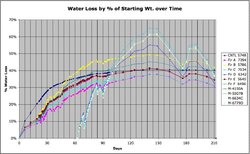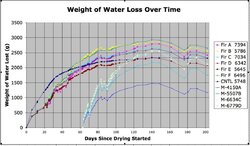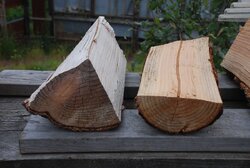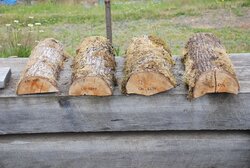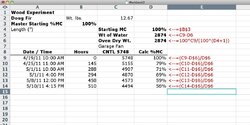Just thought I would send along an update of the graphs of the drying experiment. I finally got my first piece of fresh Oak to add to the experiment.
To recap: I started seasoning 7 splits from a Doug Fir felled, c/s/s the same day and started weighing back on April 18th. I compared 6 of them to a control split of the same group that I put in my unheated garage. For the first month I just had the 6 split on the top row of my stack. For the 2nd month I moved them next to each other to make it easier to weigh with A & B no cover, C & D clear cover, and E & F solid cover. See picture. There didn't seem to be any significant difference other than less rain wt gained for those covered which was more quickly lost. The cover blew off in July and I left them off. The number on the legends in the graphs refer to each splits starting weight in grams (Between 9-16 lbs). On June 21, I added 4 new fresh splits of maple to the experiment. I was more careful in making these 1/2 round splits of progressively larger sizes. I also added a 21" freshly cut down round(not split) of cedar on July 23. On Oct. 16, I got my first split of Oak. What a heavy son of gun, no wonder folks like it so much.
Previous posts:
https://www.hearth.com/econtent/index.php/forums/viewthread/75789/
https://www.hearth.com/econtent/index.php/forums/viewthread/76692/
From the graphs what should be clear is that the fresh "live" c/s/s wood will dry quickly at first, practically no matter the conditions. See Portland's weather last April-June if you have any doubts.
The maple added in June arrived about the time the good weather did so their moisture loss is steeper than the fir. While not as fast as split, rounds will definitely dry if conditions are right.
It has been 2 months and my splits have lost no more moisture and I wouldn't except any more loss unless I get them under cover with air movement. It's not that seasoning won't still occur, but at this point my splits have lost so much moisture that the gradient between their moisture content and outside EMC conditions is fairly flat, thus little driving force exists for the moisture to leave. Just like what happens almost every night during the entire seasoning process.
What is really clear is that most of the moisture can be lost in a very short period of time and most of the time wood is outside "seasoning" is wasted, as it the few hours where conditions are just right that really drive the moisture out. It wasn't uncommon for the splits to lose as much moisture in a sunny afternoon as in an entire week. When the wood is fresh and really wet, it has little trouble losing lots of moisture even in pretty wet conditions. I had loss rates in the first few weeks as high as 250g/day! Of course, as it get drier and closer to ambient EMC, it really slows down.
As you would expect, the bigger splits lose a % of their wt. more slowly than smaller ones but a longer skinny split of the same wt will dry faster than a shorter fatter one. What a long year of seasoning does is allow the fatter heavier splits catch up with the smaller splits that dried more quickly. Lots more I could say but I'll let the pictures do the talking.
To recap: I started seasoning 7 splits from a Doug Fir felled, c/s/s the same day and started weighing back on April 18th. I compared 6 of them to a control split of the same group that I put in my unheated garage. For the first month I just had the 6 split on the top row of my stack. For the 2nd month I moved them next to each other to make it easier to weigh with A & B no cover, C & D clear cover, and E & F solid cover. See picture. There didn't seem to be any significant difference other than less rain wt gained for those covered which was more quickly lost. The cover blew off in July and I left them off. The number on the legends in the graphs refer to each splits starting weight in grams (Between 9-16 lbs). On June 21, I added 4 new fresh splits of maple to the experiment. I was more careful in making these 1/2 round splits of progressively larger sizes. I also added a 21" freshly cut down round(not split) of cedar on July 23. On Oct. 16, I got my first split of Oak. What a heavy son of gun, no wonder folks like it so much.
Previous posts:
https://www.hearth.com/econtent/index.php/forums/viewthread/75789/
https://www.hearth.com/econtent/index.php/forums/viewthread/76692/
From the graphs what should be clear is that the fresh "live" c/s/s wood will dry quickly at first, practically no matter the conditions. See Portland's weather last April-June if you have any doubts.
The maple added in June arrived about the time the good weather did so their moisture loss is steeper than the fir. While not as fast as split, rounds will definitely dry if conditions are right.
It has been 2 months and my splits have lost no more moisture and I wouldn't except any more loss unless I get them under cover with air movement. It's not that seasoning won't still occur, but at this point my splits have lost so much moisture that the gradient between their moisture content and outside EMC conditions is fairly flat, thus little driving force exists for the moisture to leave. Just like what happens almost every night during the entire seasoning process.
What is really clear is that most of the moisture can be lost in a very short period of time and most of the time wood is outside "seasoning" is wasted, as it the few hours where conditions are just right that really drive the moisture out. It wasn't uncommon for the splits to lose as much moisture in a sunny afternoon as in an entire week. When the wood is fresh and really wet, it has little trouble losing lots of moisture even in pretty wet conditions. I had loss rates in the first few weeks as high as 250g/day! Of course, as it get drier and closer to ambient EMC, it really slows down.
As you would expect, the bigger splits lose a % of their wt. more slowly than smaller ones but a longer skinny split of the same wt will dry faster than a shorter fatter one. What a long year of seasoning does is allow the fatter heavier splits catch up with the smaller splits that dried more quickly. Lots more I could say but I'll let the pictures do the talking.


